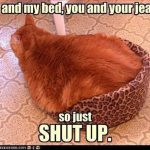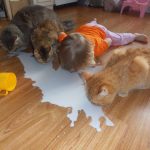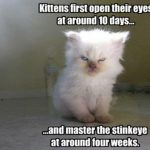Expand your knowledge about the cutest, softest, and one of the most popular pets in the world, better known as the cat. Below, Cats’ Inn Grooming & Boarding has included a couple of important topics and some fascinating facts about our feline friends. With there being more than 70 breeds of cats it is great to know a couple of things about them. Choose a topic from below to gather more information! Contact us for more information about any of these topics or our cat grooming services if you’re in the Newbury Township, Burton, Cleveland, Beachwood, or Chesterland, OH areas!
Anticipating Our New Arrival
Really need help. MUST GO!!!
Please help! After two long years of being on a waiting list for a cat, we have been notified by breed rescue that, at long last, our number has come up and … WE ARE HAVING A KITTEN!
We must get rid of our children IMMEDIATELY because we just know how time consuming our new little kitten is going to be and it just wouldn’t be fair to the children. Since our little kitten will be arriving on Monday we MUST place the children up for adoption this weekend!
They are described as:
- One male — his name is Tommy, Caucasian (English/Irish mix), light blonde hair, blue eyes. Four years old. Excellent disposition. He doesn’t bite. Temperament tested. Does have problems with peeing directly in the toilet. Has had chicken pox and is current on all shots. Tonsils have already been removed. Tommy eats everything, is very clean, house trained and gets along well with others. Does not run with scissors and with a little training he should be able to read soon.
- One female — her name is Lexie, Caucasian (English/Irish mix), strawberry blonde hair, green eyes quite freckled. Two years old. Can be surly at times. Non-biter, thumb sucker. Has been temperament tested but needs a little attitude adjusting occasionally. She is current on all shots, tonsils out, and is very healthy and can be affectionate. Gets along well with other little girls and little boys but does not like to share her toys and therefore would do best in a one child household. She is a very quick learner and is currently working on her house training. Shouldn’t take long at all.
We really do LOVE our children so much and want to do what’s right for them. That is why we contacted a rescue group. But we simply can no longer keep them. Also, we are afraid that they may hurt our new kitten.
I hope you understand that ours is a UNIQUE situation and we have a real emergency here! They MUST be placed into your rescue by Sunday night at the latest or we will be forced to drop them off at the orphanage or along some dark, country road. Our priority now has to be our new kitten.
Fleas In Cats
I get many calls from people wanting a flea bath for their cat.As much as I would like to make the money for giving a flea bath, I prefer not to do it. Here are the reasons why, and what I suggest to people.
- Flea bath chemicals can be very harsh and you should not use them if you are going to use other flea products on the cat or in the house.
- After bathing, the fleas will be gone from the cat until you go back home. Fleas live in carpeting and bedding. The fleas will jump right back on after the flea bath “wears” off.
- How do you get fleas in your house if your cat never goes outside? Fleas can come in on your clothes if you come into contact with another animal with fleas, or if you walk in the grass. Fleas can come in through a crawl space or basement. If you get any rodents in your house, such as mice or squirrels, they can be carried in. Fleas multiply quickly.
- If you have a serious flea problem in the house, it is best to call a professional pest control company to treat for fleas. Do it yourself flea bombs are a hassle, they stink, and can be dangerous. If the flea problem is not severe, you can buy Adams Plus Flea Spray at a pet store or online. Make sure that the label states that it kills fleas, eggs, and larvae. It can be used on the premises or on the pet. Spray your carpeting, furniture, and your pet’s sleeping areas. Read directions on the bottle.
- After the house is treated, you can buy Capstar from a pet store, online, or from your vet. One pill kills all fleas on the animal in one hour. Then start spot-on flea control on the cat. Advantage or Revolution are the two products I use. Frontline, or off the shelf fipronil products (fipronil is used in Frontline) do not work very well. Vets have told me that the fleas seem to be developing a resistance to fipronil. I have groomed several animals in which the owner uses frontline, and I have found fleas and ticks on them. I would never use a flea collar. They smell awful and burn my eyes. I can imagine it is just as awful to a cat. The seresto flea collars work, but they do not have a safety release and an animal could strangle if it snags on something. They are also expensive, and if your pet loses it outside, you are out a lot of money.
- Whatever you choose, make sure to read the directions. Make sure you choose a product for the correct weight of your cat. NEVER use a product that is labeled for dogs on a cat. If your cat gets an overdose or has a reaction, such as vomiting, lethargy, or seizures, get him to a veterinarian immediately.
- Once the fleas are gone, if your cat still has leftover flea dirt and debris in his coat, then is the time to have a bath with cat shampoo, not flea chemicals. Giving a flea bath while there are still fleas in the house is a waste of your time and money.
- If your cat has had fleas, he will probably get tapeworms. Tapeworm segments look like tiny pieces of rice clinging to your cat’s butt. They get them from swallowing fleas when grooming themselves. After the flea problem is gone, you may have to deworm your cat for tapeworms. You can find tapeworm tabs in pet stores, online, or from your vet. Make sure the dose is weight appropriate and read directions.
What is Hyperthyroidism?
Hyperthyroidism results from an overproduction of thyroid hormones (mainly T4) from a tumor in the thyroid gland. This tumor, in over 97% of all cases, is a benign (non-cancerous) adenoma. To repeat, hyperthyroid patients do not have cancer except in very rare (2-3%) cases where a thyroid carcinoma is the cause of the disease.
An elevation in thyroid hormones increases the metabolic rate of the body which puts stress on the heart, kidneys, nervous system, gastrointestinal tract, liver, as well as all other organs of the body.
Think of how hard your car’s engine has to work and how much fuel it uses if you rev up the motor (increase its rpms) by stepping on the gas pedal while in neutral.
This is what is happening inside your hyperthyroid cat’s body. Every organ system is under the negative influence of an abnormal increase in the body’s metabolism.
In the analogy above, food is your cat’s fuel and it is being used at a faster rate than normal which results in an increased hunger and weight loss.
Hyperthyroidism is eventually fatal if left untreated.
What are the signs of hyperthyroidism?
Since elevated thyroid hormones negatively affect every organ system in the body, the clinical signs are extremely varied but include some or all of the following – with an increased appetite and weight loss being the two most common:
- increased appetite (but sometimes decreased)
- weight loss (fat and muscle) in the face of a good appetite
- increased activity (“acting like a kitten again”)
- increased drinking and urination
- vomiting
- diarrhea
- heart disease – increased heart rate/’pounding’ heartbeat
- increased respiration rate
- hair coat/skin/nail abnormalities
- nighttime yowling/restlessness/confusion/behavior changes
- high blood pressure (hypertension) – Please note that if your cat’s eyes look like big black pools (dilated pupils), this is a sign of possible retinal detachment which can occur secondary to high blood pressure and will result in partial or total blindness. Not all hyperthyroid cats become hypertensive but is a good idea to have your veterinarian monitor your cat’s blood pressure.
What are the treatment options for hyperthyroidism?
There are 4 treatment options for hyperthyroidism:
- radioactive iodine (I-131) – the ‘gold standard‘ – cures hyperthyroidism
- anti-thyroid medication (e.g. methimazole) – controls hyperthyroidism
- surgery – cures hyperthyroidism
- Hill’s y/d (a diet deficient in iodine – canned and dry) – controls hyperthyroidism
Radioactive iodine – 131 (I-131)
Radioactive iodine is the treatment of choice for hyperthyroidism in nearly all cases. This treatment involves an injection of a very small dose of radioactive iodine that is placed just under the skin. Because the thyroid gland heavily concentrates iodine, the thyroid tumor will be selectively destroyed.
In addition to the thyroid tumor being targeted, any other ectopic (found somewhere other than its normal location) overactive thyroid tissue will also be destroyed. This ectopic tissue is often located in the chest cavity.
A small risk (~5%) of hypothyroidism (the opposite of hyperthyroidism) exists if too much of the normal tissue is also destroyed. These cats will need to receive thyroxine supplementation temporarily or for life.
On the flip side, a small number of cats (~5%) remain hyperthyroid (and require a second treatment) if not enough of the adenoma is destroyed or if the patient actually has a carcinoma (cancer) instead of a benign adenoma. In the case of a carcinoma, a higher dosage of I-131 is needed to effectively treat the disease.
Anti-thyroid medication:
Methimazole (Tapazole and Felimazole)
There are many cats that do well on these drugs but side effects are not uncommon and include nausea, vomiting, and severe allergic/itchy facial skin reactions and, less frequently, life-threatening liver dysfunction, bone marrow disease, and bleeding problems.
While these drugs effectively lower the thyroid hormones and ameliorate the clinical signs of hyperthyroidism, they do not address the underlying tumor and, therefore, the tumor will continue to grow with the risk that it will become malignant cancer over time.
As the tumor continues to grow, the dosage will often need to be raised which means that the patient must be monitored with periodic blood tests for life. The frequency will depend on the patient but as we all know, trips to the veterinarian are expensive and very stressful for the patient.
Other health factors may necessitate lowering the dosage. Therefore, lab monitoring is very important for these patients.
At first glance, I-131 may appear to be a more expensive treatment but in many cases, it turns out to be less expensive when compared to lifelong treatment with methimazole when the cost of the medication and the continued monitoring are considered. Also, the hassle of twice-daily medication must be considered.
Surgery
Surgery to remove the thyroid adenoma has fallen out of favor since I-131 became available. This is true for several reasons.
- It is impossible to differentiate normal tissue from tumor tissue. If both lobes of the gland are involved and removed, this will result in hypothyroidism necessitating lifelong treatment with thyroxine.
- The parathyroid gland which sits right next to the thyroid gland can be damaged or accidentally removed. The parathyroid gland is critical for calcium balance in the body and if damaged or removed, serious complications, including death, can result.
- General anesthesia is necessary which is always a risk, but even more so in an older patient with hyperthyroidism considering how many organs are negatively affected by this disease. Severe heart disease can be present in these patients especially if they have been hyperthyroid for a long time. Any level of heart disease will increase the risk associated with anesthesia.
- Some hyperthyroid cats have ectopic (not in the normal location) thyroid adenoma or carcinoma tissue located in the chest cavity which the surgeon will not be able to remove. Plus, the surgeon will not even be aware of its presence unless a thyroid scan was performed.
Iodine deficient diet
Y/d is formulated to be deficient in iodine with the simple goal of providing less ‘building material’ for the patient’s thyroid tumor and normal glandular tissue to make thyroid hormones (T3 and T4). Iodine is an important component of these hormones withT3 needing 3 iodine atoms and T4 containing 4 iodine atoms. The premise of this diet is simply to starve the thyroid gland of iodine but here is where the issue of tunnel vision’ nutrition comes into play. In addition, the expense of the food and the ongoing blood work makes this option expensive in the long run.
While starving the thyroid gland of iodine, the entire body – including the thyroid gland itself – is also negatively affected by this deficiency.
- y/d leaves the whole body in a state of iodine deficiency. This is an excellent example of tunnel vision nutrition – i.e.- only paying attention to the thyroid gland, in this case, and not the rest of the body. Safety studies have not been conducted to assess the long-term damage to the body when left in an iodine-deficient state. Most of our knowledge of iodine centers around the thyroid gland but there is strong evidence pointing to iodine as playing an important role in immune health, adrenal function, breast health, and also having antioxidant properties.
- y/d does not address the disease process (tumor) that is causing the hyperthyroidism and the tumor will continue to grow. Therefore, it does not “restore thyroid health” as claimed. The longer the tumor is allowed to grow, the higher the chance of it becoming a malignant carcinoma.
- y/d is too low in protein for many cats especially considering the muscle-wasting state that hyperthyroid cats are already in.
- y/d is too high in carbohydrates. Note that many hyperthyroid cats have sub-clinical diabetes. Feeding them a high carbohydrate diet could very well tip them over the edge into overt diabetes.
- dry y/d has an extremely unhealthy ingredient list for an obligate carnivore and it is water-depleted. Corn Gluten Meal, Animal Fat (preserved with mixed tocopherols and citric acid), Whole Grain Corn, Soybean Mill Run, Dried Egg Product, L-Lysine, Chicken Liver Flavor…..
- Please read the above ingredient list with your cat’s obligate carnivore status in mind. Also, understand that your hyperthyroid cat needs a high amount of high-quality protein since the disease is causing his body to ‘eat’ (catabolize) his own muscle mass.
- Corn is not a “high quality” protein for a carnivore.
- The patient cannot be allowed to eat any other food which means no treats of any kind. He must eat only y/d which can pose a problem in multiple-cat households or if he suddenly stops eating the food.
- This diet cannot be fed to non-hyperthyroid cats. Hill’s states that it can be fed to normal cats if these cats are also fed some regular food. However, I would not subject your healthy cat to this diet with the hope that you feed enough food from another source to meet his iodine needs – especially in light of the fact that there are diets on the market that are very low in iodine – too low to furnish enough iodine to make up for the bulk of the diet being iodine-deficient.
- There is compelling scientific evidence to show that feeding an iodine-deficient diet can actually make the hyperthyroid patient worse over time.
- When there is not enough iodine in the body, thyroid hormones decrease. This signals the pituitary gland to secrete TSH (thyroid stimulating hormone). TSH’s action on the thyroid gland causes it to grow larger (hypertrophy/goiter).
“A recent case-control study reported that cats consuming commercial foods which were relatively deficient in iodine were more than 4 times as likely to develop hyperthyroidism compared with cats that ate iodine-supplemented foods.”
“Could y/d make this situation worse?”
…..will lowering T4 and T3 secretion in these hyperthyroid cats lead to increases in circulating TSH and continued stimulation of thyroid growth and proliferation in some cats? Will this TSH stimulation cause transformation of benign adenomatous thyroid tissue to carcinoma, as has been documented to occur in some hyperthyroid cats?
The short answer is this: we simply do not know. The long-term safety studies needed to answer this question have not yet been done.
Dr. Mark E. Peterson, DVM, DACVIM, Animal Endocrine Clinic
September 2012
Lisa A. Pierson, DVM
[email protected]
Is Canned Food Good For Your Cat?
Alexandria, Va.Canned food, because of the way it is formulated and prepared, is much higher in protein and lower in carbohydrates than dry cat food, regardless of the “quality” of the brand. Obviously, it also has a much higher moisture content. Recent research is making it clear that it is nutritionally dangerous to feed cats diets that are too high in carbohydrates. This is because cats are obligate carnivores – they are designed to acquire their nutrition from meat sources. When you think of a mouse, what is it made of? It is about 45% protein, 45% fat, and less than 5% carbohydrates. It also contains a lot of water. This is what we want to feed our cats. For years we have been feeding cats dry foods (in general 35-60% carbohydrates), primarily for convenience to the owner and because grain-based carbohydrate ingredients are cheaper for manufacturers than quality meat ingredients. In fact, cats lack the enzymes necessary to efficiently convert carbohydrates into energy for storage. They are very efficient at converting protein, however. If fed too many carbohydrates, the resulting glucose produced lingers in their bloodstream for a prolonged period of time. It interferes with insulin production, lipid metabolism, and digestive system health. Cats also seem less satisfied by the calories they consume as carbohydrates. Their brains require protein by-products to get the message “I am full”. So, if fed high carbohydrate diets, they are more likely to overeat and not be satiated. Pet owners and veterinarians are now facing an epidemic of obesity and diabetes in cats that have emerged over the last 15 years because of these facts. Finally, cats are not big drinkers. While cats on dry diets will drink water, they generally take in about 1/3 less water than canned food eaters. This may well be contributing to the increased frequency of cats in our practice that suffer from urinary tract/renal disease and constipation.WHAT BRANDS SHOULD I FEED? The first thing to know, feeding ANY brand of canned cat food is probably
preferable to feeding dry food, even a premium brand. As a general guideline, we would recommend feeding a canned diet whose first 2 or 3 listed ingredients are meats, meat broths and not by-products or grains. Finding these diets can be difficult in the supermarket, so again, we say that feeding ANY canned food is better than feeding dry.The VERY IMPORTANT EXCEPTION is canned foods with cornstarch, food starch, or cellulose. Make sure you look for these on the label so as to avoid these high carbohydrate ingredients. We would recommend that any diet chosen have received AAFCO (American Association of Feed Control Officials) approval; this should be noted on the label.
My Cat Doesn’t Go Outside, Should I Vaccinate?
My cats do not go out, but I still vaccinate them. I will tell you some very good reasons why. Your cat might escape to the great outdoors and could come into contact with a sick stray or even an unvaccinated neighbor’s cat that is sick.
Your cat might even go nose to nose with a sick cat through a window screen.
Bats do get into homes, and bats are common carriers of rabies and you know how much cats like to catch things that fly.
A rabid raccoon or another wild animal might get into your home. I read a news article about a man who opened his door to get the newspaper and a rabid raccoon rushed in and attacked his dog. Luckily, the dog was vaccinated and the owner did not get bitten.
If you have to board your cat, kennels and groomers want to see a record of vaccination. Ok, so maybe your neighbor watches your cat when you are out of town, but what if there is a house fire or flood? You may have to get the cat out of the house until you can move back into your home. Most insurance companies will pay for pet boarding in the event of a disaster. Also, keep in mind that it takes a couple of weeks for the vaccine to build up immunity. Do NOT wait until the day before boarding to vaccinate your cat, because it takes time for immunity to build up.
If your cat becomes ill and needs a trip to the veterinarian, there may be a sick cat in the waiting room, or even hospitalized. Some viruses are transmitted in the air, some by transfer from hands or surfaces, and some by direct contact. Also, most vets require that your pets be vaccinated, and it is not a good idea to vaccinate a sick animal. It is the law that pets be vaccinated for rabies.
Why risk it? The feline distemper virus (panleukopenia) is horrible. It is a parvovirus like a virus that can infect dogs. It spreads from cat to cat rapidly and can be fatal in a very short time. Calicivirus is another virus that can be fatal. Feline herpes virus is forever, and your cat will periodically break out with herpes virus once he has been infected. It causes sneezing, runny eyes, and can progress to a bacterial infection. The chlamydia virus affects the eyes and causes runny eyes and can lead to bacterial infection. And of course, we all know about the dangers of rabies. Rabies is always fatal and can be transmitted to humans and other animals through bite wounds.
After the first rabies vaccine, the next one given one year later won’t have to be repeated for three years. The distemper vaccine (FVRCP) can be repeated every two years after initial vaccine and boosters. If your vet insists on every year vaccines, ask the vet if he follows the vaccine recommendations of the American Veterinary Medical Association. Although allergic vaccine reactions are rare, always keep a close eye on your cat for at least an hour after vaccination. If you see drooling, coughing, vomiting, diarrhea, dilated pupils, or any sign of stress, immediately call your vet and bring your cat in. Reactions can happen up to 24 hours after vaccination, however, it is usually less severe if it happens after the first hour. Your cat might not seem to feel good and possibly not eat the day after vaccination but this is normal. If it lasts more than a day though, contact your vet immediately.
If your cat does go outside, he should also be vaccinated for feline leukemia. Unfortunately, the FIV vaccine for a feline immunodeficiency virus (FIV feline aids) is not thought to be reliable, so you are still putting your cat at risk if you let him outside.
Questions for the Kennel Owner
- You are going out of town and are wondering what you should do with your feline friend and don’t just want to leave them just anywhere. Boarding and pet sitting for your feline friend have their pros and cons and you will choose whatever is right for you. I, personally, have heard many “horror” stories about boarding and pet sitters. Do your “homework”, observe, and ask the right questions to ensure that you are making the right choice.
- Can you visit the kennel before you drop off your dog or cat?
- Are there references available?
- Is it clean? Does it smell of ammonia or just plain awful?
- Is there clean water in front of every animal?
- Is there dirty laundry and trash piled all over the place?
- Any evidence of parasites?
- Does the kennel owner live on the premises?
- What if my dog or cat does not eat? (An answer of “they will eat eventually” is not correct!) Especially cats. If they go for more than a couple of days without eating, there is a high risk of developing liver lipidosis. It is similar to cirrhosis in humans. It is very time consuming and expensive to treat, and can be fatal.)
- Does the kennel insist on feeding their own brand of food? Your cat or dog will be more comfortable eating what he or she is used to eating. Dogs can very sensitive to stomach upset from changes in diet. Diet changes can also lead to pancreatitis.
- What do you consider an emergency or indication of illness that would require a trip to the vet? Answers: Straining to urinate or defecate, unrelenting vomiting or diarrhea, lethargy, coughing, sneezing, fever, (can the kennel owner take a temperature?), (in cats, if the third eyelids are showing, that is often an indication of illness), severe lameness, or suddenly stopping eating when the cat or dog has had a normal appetite.
- Is the kennel owner willing to administer medications provided by you or your veterinarian? If my vet is not available or open, does the kennel owner have “on call” a veterinarian that will see a cat or dog that is not his or her client? Is the kennel owner willing to transport my pet to a veterinarian?
- There are great boarding facilities out there, large and small, but you always want to ensure your feline companion is in the best of hands. If someone will be pet sitting in your own home, you want to make sure that you have asked all the right questions. Below are a couple of questions that you should ask before hiring anyone to pet sit.
- Are there references available? This is very important. When using a cleaning service, I found out that “bonded and insured” means that it must be proven that an item was stolen by the service employee before a claim is paid. Talking to a satisfied client is best.
- If my dog or cat gets sick, will he or she be taken to a veterinarian?
- What if my dog or cat does not eat? (An answer of “they will eat eventually” is not correct!) Especially cats. If they go for more than a couple of days without eating, there is a high risk of developing liver lipidosis. It is similar to cirrhosis in humans. It is very time-consuming and expensive to treat and can be fatal.)
- What do you consider an emergency or indication of illness that would require a trip to the vet? Answers: Straining to urinate or defecate, unrelenting vomiting or diarrhea, lethargy, coughing, sneezing, fever, (can the boarding facility take a temperature? Does he or she carry a thermometer?), (in cats, if the third eyelids are showing, that is often an indication of illness), severe lameness, or suddenly stopping eating when the cat or dog has had a normal appetite.
- Is the boarding facility willing to administer medications provided by you or your veterinarian?
- If my vet is not available or open, does the boarding facility have “on call” a veterinarian that will see a cat or dog that is not his or her client?
Things for you to do
- Make sure that your pet’s vaccinations are up to date.
- Provide the food and written instructions.
- Provide a cell phone number or other numbers to reach you in case of emergency.
- Plan ahead. Make your reservations early.
- If you’ve found a good kennel or boarding facility, let your friends with cats and dogs know.
Cat Man
“My fears for the planet subside
In spite of the struggle and strife,
When I see a man, big and brawny, who can
Find room for a cat in his life.
No knight on a prancing white charger for me,
The man I am seeking, instead
Was hugging his pet on the way to the vet
And planted a kiss on his head.”
–
This is one of my favorite poems. I do not know the author. Do you?
If you have any favorite poems, stories, or jokes about pets, please forward them to me.
Off to The Vet or Boarding Kennel?
A Letter from Lynn About Cat Grooming
Cats go to a groomer for many reasons. They may be matted, which is painful and can cause skin tears and infection. The owner may not like all the hair and want it shaved off of the cat. Whatever the reason might be, it is a good idea to make sure that the cat is handled safely. Ask your groomer if you can stay while the cat is being groomed or ask if the groomer can come to your home. You can observe how your cat is handled and how he or she reacts to grooming. If the groomer will not allow you to stay, get another groomer. Cats are not dogs, and they should be handled properly. Is the cat put in a groomers’ loop? A cat should NEVER be put in a groomers loop. Their necks are very fragile and they can easily break a neck or strangle. A figure 8 harness is acceptable.
Is the cat groomed in a quiet area that is free of loud noises such as force dryers and barking dogs?
Is the room secure? If the cat jumps off the table, is there a way for him to escape if a customer happens to walk in the door?
Is the cat ever left unattended on the grooming table? The answer should be “no”.
Does the groomer give any sedatives to the cat? A groomer should never administer any medication unless the medication is cleared by and provided by your veterinarian.
Are all products used on your cat labeled as “safe for cats”? Many products that are safe for dogs, horses, or even yourself are not safe for cats. Flea products must be labeled for cats and the correct dosage must be used. Alcohol, essential oils, tea tree oil, and dimethicone are products that often used for dogs, but are not safe for cats. A cat’s liver metabolizes things differently from other species. Every time an unsafe product is used, there is the possibility of immediate danger or the possibility of slowly poisoning your cat every time these products are used. PineSol and Lysol should never be used near cats. In addition to licking off an unsafe product, the product may be absorbed through the skin or inhaled. Since there are so many products that are not safe for cats, the best thing to do is check the label. If it does not specifically say “safe for cats”, do not allow it to be used on your cat. Interestingly, I have come across products that are labeled “pet safe”. When I have called the manufacturer, they often tell me not to use it on cats. I always check.
Unfortunately, some cats become too stressed to groom. Panting, drooling, loss of bowel control, dilated pupils, extremely elevated heart rate, elevated respiration, elevated temperature, or collapse are indications that the grooming should not continue. Extreme stress can kill your cat. It would be safer and kinder to talk to your veterinarian about having your vet groom the cat so that your vet can administer the proper sedation to get the job done. If your cat has kidney disease, diabetes, a heart condition, hyperthyroidism, or is old or fragile, please consult your veterinarian before scheduling grooming.
Lynn Tezak
Master Cat Groomer
Professional Cat Groomers Association of America
Cats’ Inn 440 596 8347
Fun Photos!
Health Benefits of Owning a Cat
When you think of items that can help you increase your health, you do not often think about pets. Especially, cat ownership may not come to mind. However, health professionals and researchers are finding that owning a cat can actually benefit your health. You can enjoy a number of benefits from cat ownership. Here are 17 health benefits associated with owning a cat:
- Lower risk of cardiovascular disease: Apparently, if you own a cat, you are less likely to die of cardiovascular disease. Indeed, a study from the University of Minnesota found that those without cats were between 30 and 40 percent more likely to die of cardiovascular disease than cat owners. Does it work for owning dogs as well? According to the study, dog owners didn’t reap the same benefits as cat owners.
- Reduce risk of heart attack: You can reduce the chances that you will end up with a heart attack when you own a cat. Not only will your entire cardiovascular system thank you, but you can reduce the chance that you die suddenly due to heart attack if you own a cat.
- Improve your immune function: Owning a cat can help your immune function improve. The feelings you get related to the cat can help you give your immune system a boost. Cats often know when you are ill, and can come and provide you with comfort, helping you get better while boosting your immune system.
- Decrease chance of developing allergies: If you are going to have a baby, you might consider getting a pet. Having a cat can help you prevent allergies in your children. There are some studies that newborns that live with animals, specifically cats and dogs, are more likely to avoid developing allergies. Being used to them from an early age triggers immunity.
- Help prevent asthma in children: In addition to helping to prevent children from developing allergies, there is some evidence that living with a cat can also help prevent asthma in children. If you have kids, owning a cat and exposing your kids to cats might help them to avoid developing asthma. Early and regular contact with cats can help your children avoid a number of respiratory problems.
- Reduce blood pressure: You can help reduce your blood pressure by enjoying the company of a cat. Indeed, having a cat can lead to lower blood pressure. Just stroking a cat is calming and lowers blood pressure. Those who own pets, according to a State University of New York at Buffalo study, are more likely to have lower blood pressure than those who do not have pets.
- Lower triglycerides: You can lower your triglycerides by exercising and eating fewer carbohydrates (especially from processed foods). But that’s not the only thing you can do. Some studies indicate that if you have a cat, you can lower your triglycerides and boost your health by owning a cat. While you should probably still exercise and eat better, owning a cat can help the process along.
- Lower cholesterol: Are you trying to lower your cholesterol? If so, consider getting a cat. Interestingly, cat owners have lower cholesterol than those who do not own cats. A 2006 study in Canada showed that owning a cat was actually more effective at lowering cholesterol than the medications designed to do that same thing. Indeed, you could save money on meds and improve your health, possibly, by becoming a cat owner.
- Reduced risk of stroke: The prospect of having a stroke is scary. If you are concerned about having a stroke, you might consider cat ownership. Owning a cat can cut the risk of stroke. A study at Minnesota University found that cat owners could cut their risk of stroke by 1/3. The idea that you can help reduce the changes of getting a stroke, thanks to a cat, is one reason to consider cat ownership.
- Reduce stress: Having a cat can help reduce the stress in your life. Having a cat has many psychological benefits, and one of those is relieving stress. Being able to care for an animal, or having a cat snuggle with you, can help you feel better, and reduce your level of stress.
- Reduce anxiety: Not only can owning a cat help reduce the stress that you feel, it can also reduce your anxiety. Petting a cat is calming, as are other aspects of caring for cats. When you are concerned with caring for another creature, it can help you take your mind off your worries. Additionally, the presence of a cat that will snuggle with you can help you calm yourself as your enjoy the unconditional love of a cat.
- Improve your mood: In many cases, interacting with a pet can help improve your mood. This includes cats. Owning a cat can help you feel better in general, boosting your mood. If you are looking to see mood improvement, a cat can help with that.
- Help with depression: Owning a cat can also help relieve depression. While a cat may not actually “cure” depression, it can help take your mind off your problems, and focus on something else. The love a cat offers can also be soothing to the mind. If you are depressed, cat companionship can help you in your battle.
- Help with autism: Autism is marked by difficulty in social interaction and communication. Those with autism have a hard time communicating in the same way that others do. Having a cat can actually help in these cases. There have been instances where cats have been instrumental in therapy for autistic children. Other developmental disorders can be helped with exposure to cats as well.
- Reduced loneliness: Many who have feelings of loneliness can find relief with a pet. Cat companionship can help those who are lonely feel a connection with another life. Just having a cat to come home to and spend time with can help those who are single, or widowed.
- Fewer health care visits: Those with cats make fewer visits to health care professionals. This includes visits to the doctor, and hospital visits. Studies have also shown that nursing homes that allow cats as part of the therapy for patients have lower medication costs than facilities that do not make use of cats as part of therapy.
Longer life: Along with being married and avoiding main roads, you can enjoy a longer life with a cat. Cats provide a number of benefits that can lead to a longer life, including a form of social interaction. So, if you want to be healthy and live a little bit longer, consider owning a cat.






